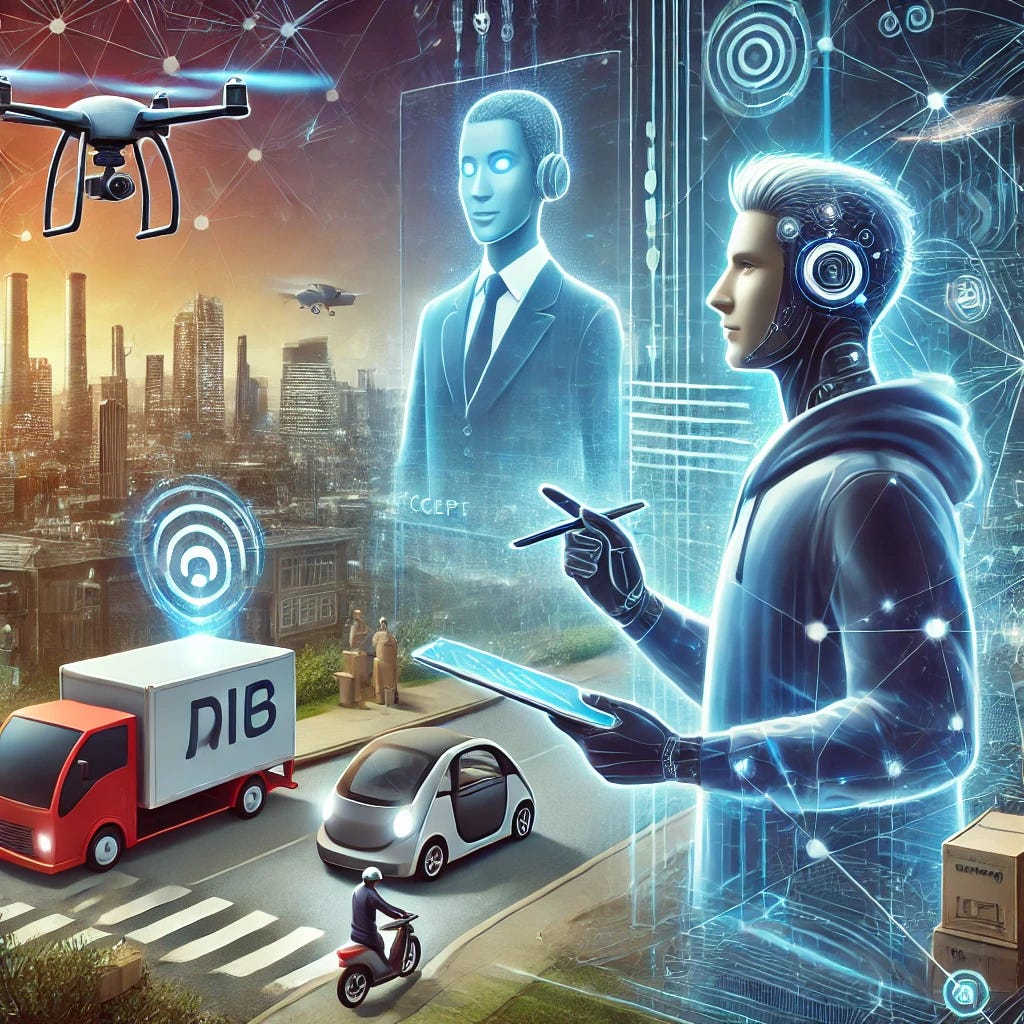Voice-over provided by Amazon Polly
Also, check out Eleven Labs, which we use for all our fiction.
AI and the Gig Economy: Transformation or Disruption?
The gig economy, driven by short-term contracts and freelance work, has grown significantly over the past decade. Platforms like Uber, Upwork, Fiverr, and TaskRabbit have allowed millions of workers to earn income on their own terms, offering flexibility and independence that traditional employment often lacks. However, artificial intelligence (AI) is poised to redefine the landscape in ways that could both enhance and disrupt gig work.
From automation to algorithmic management, AI is rapidly reshaping how gig workers find jobs, set their rates, and interact with clients. Machine learning-driven recommendations help match workers to opportunities more efficiently, reducing the time spent searching for gigs. Predictive analytics improve demand forecasting, allowing platforms to balance worker availability with consumer needs. AI also enhances communication tools, enabling seamless collaboration between gig workers and their clients, even across different time zones and languages.
However, these advancements also introduce challenges. The increasing reliance on AI raises concerns over algorithmic transparency and fairness, as workers often have limited insight into how AI-driven decisions affect their job prospects and pay rates. Automated ranking systems, customer feedback analysis, and hidden performance metrics can create an environment where workers feel powerless against opaque decision-making. As AI takes a greater role in shaping the gig economy, balancing efficiency with worker rights will be a critical challenge for the future.
AI-Powered Platforms: The New Middlemen
Many gig economy platforms already use AI to match workers with tasks, optimize pricing, and manage customer interactions. AI-driven algorithms determine everything from ride-hailing fares to content recommendations for freelancers. As these systems become more sophisticated, they will refine demand forecasting, ensuring optimal resource allocation. AI is also being integrated into dispute resolution processes, with some platforms using machine learning to assess customer complaints and determine potential refunds or penalties for workers.
However, the increasing reliance on AI also raises concerns. Gig workers often have limited visibility into how algorithms determine their earnings or job availability. The lack of transparency can create a sense of power imbalance, with workers struggling to challenge automated decisions that affect their livelihoods. Without human oversight, workers may find themselves penalized for factors beyond their control, such as customer feedback misinterpretations or algorithmic biases. Additionally, the absence of standardized AI regulations means that different platforms implement their own opaque decision-making models, leading to inconsistencies in worker treatment.
Another concern is algorithmic favoritism, where AI-driven systems prioritize certain workers based on engagement metrics, customer feedback, or hidden performance factors. This can create an uneven playing field, making it harder for new or less active gig workers to secure work. AI also enables dynamic pricing models, which can fluctuate unpredictably based on demand, making it difficult for workers to anticipate their earnings. These rapid shifts in pay and job distribution further highlight the need for greater transparency and oversight in AI-driven gig economy platforms.
Automation and the Future of Gig Work
One of AI's most significant impacts will be the automation of tasks traditionally performed by gig workers. Industries reliant on gig labor—such as transportation, customer service, and digital content creation—are already seeing AI-driven replacements.
Rideshare and Delivery: Autonomous vehicles and delivery drones could significantly reduce the need for human drivers, cutting opportunities in sectors where millions currently earn their income. As self-driving technology improves, gig workers may need to shift toward roles that involve maintenance, oversight, or customer service elements that automation cannot fully replicate.
Customer Support: AI chatbots and virtual assistants are replacing freelance customer service representatives, streamlining business operations while reducing demand for human agents. However, AI is not yet perfect, and human workers will still be needed for high-level inquiries, complex problem-solving, and maintaining customer relationships.
Creative Work: AI-generated content, from articles to graphic design, threatens freelance writers, artists, and video editors by offering faster and cheaper alternatives. AI-powered tools such as generative language models, automated video editing software, and AI-assisted design platforms are reshaping the creative landscape, pushing gig workers toward roles that emphasize originality, strategy, and nuanced creativity.
Despite these changes, AI will also create new gig opportunities. Workers who can adapt—by leveraging AI as a tool rather than a competitor—may find themselves in emerging niches that require human-AI collaboration. For example, AI-assisted design work, personalized AI-driven marketing campaigns, and high-touch customer experience services still require human intuition and expertise. Additionally, some platforms are beginning to embrace "human-in-the-loop" models, where AI handles repetitive tasks while workers oversee and refine outputs to ensure quality.
New Opportunities: AI as an Enabler
While AI is eliminating certain jobs, it is also creating new types of gig work. These include:
AI Trainers and Moderators: As AI systems need continuous refinement, companies are hiring freelancers to label data, provide human oversight, and correct AI-generated errors. This growing sector allows workers to influence and improve AI accuracy. Additionally, ethical AI consultants are becoming increasingly valuable, ensuring AI models adhere to guidelines and fairness standards.
Personalized AI Assistants: Entrepreneurs and executives may hire AI-powered virtual assistants, but these assistants still require human guidance and fine-tuning to be fully effective. These roles include training AI to better understand nuanced client preferences and managing its interactions for a more natural and seamless experience.
AI-Enhanced Freelancing: Gig workers using AI-powered tools—such as automated research assistants, coding helpers, and design generators—can increase efficiency and expand their offerings. Those who embrace AI as a tool can gain a competitive advantage by delivering higher-quality work at a faster rate. AI-driven automation can help freelancers manage their workload, automate mundane tasks, and optimize their business strategies.
Tech Support and AI Integration Specialists: As AI tools become more widespread, businesses will need workers who can integrate, troubleshoot, and maintain AI-driven workflows. This will create a niche for technically skilled gig workers. Companies are increasingly hiring AI adoption consultants to help them integrate AI into their operations.
AI-Powered Content Review and Curation: As AI-generated content becomes more prevalent, businesses are hiring human curators to review AI-generated material, ensuring quality control, fact-checking, and alignment with brand messaging. This creates opportunities for editors, marketers, and subject-matter experts to refine AI outputs and maintain high standards.
Rather than replacing humans outright, AI is shifting the nature of gig work from manual execution to AI-assisted problem-solving. Gig workers who understand how to use AI-driven tools can differentiate themselves and command higher rates for their expertise. The ability to leverage AI efficiently will soon become a critical skill in the gig economy, with those who embrace AI positioning themselves as leaders in the evolving workforce.
Algorithmic Control: Who’s in Charge?
One of the more controversial aspects of AI’s role in the gig economy is algorithmic management. AI-driven platforms often dictate worker conditions—assigning tasks, setting pay rates, and enforcing performance metrics. This can create an environment where gig workers feel like they are working for a machine rather than with one.
Issues such as algorithmic bias, opaque ranking systems, and automated account deactivation without human oversight remain challenges. For example, gig workers might be penalized for rejecting jobs without understanding how this impacts their future earnings. The lack of an appeals process for algorithmic decisions further complicates the issue, leaving many in precarious work situations.
As AI takes on a greater role in workforce management, there is a growing demand for regulation to ensure fair treatment and accountability.
Thank you for your time today. Until next time, stay gruntled.
Do you like what you read but aren’t yet ready or able to get a paid subscription? Then consider a one-time tip at:
https://www.venmo.com/u/TheCogitatingCeviche
Ko-fi.com/thecogitatingceviche







